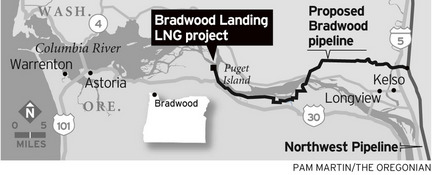forum
library
tutorial
contact

Energy Regulators Up Timeline
for Liquid Gas Terminal
by Ted SickingerThe Oregonian, January 4, 2010
|
the film forum library tutorial contact |

|
Energy Regulators Up Timeline
by Ted Sickinger |
 The molasses-slow regulatory process governing proposed liquefied natural gas projects in Oregon moves to the high burner this week after federal energy regulators told their fisheries counterparts to get on with their analysis of whether the Bradwood Landing LNG terminal and pipeline would jeopardize endangered species.
The molasses-slow regulatory process governing proposed liquefied natural gas projects in Oregon moves to the high burner this week after federal energy regulators told their fisheries counterparts to get on with their analysis of whether the Bradwood Landing LNG terminal and pipeline would jeopardize endangered species.
The so-called biological opinion from the National Marine Fisheries Service is a key regulatory hurdle for the project. Not only is Bradwood's federal license conditioned on a clean bill of health from the fisheries agency, but the analysis also informs other state and federal permitting processes.
Bradwood's backer, Houston-based NorthernStar Natural Gas, wants to build a terminal and storage facility at a former mill site 25 miles east of Astoria. The plant would offload super-cooled liquefied natural gas from tankers, reheat it to a gas and ship it to market or storage facilities around the West through a pipeline.
Opponents of the terminal say it would be plunked into the most important salmon nurseries on the lower Columbia, with devastating impacts from dredging, ballast water intake and the turbidity from operation of the terminal. Project backers believe those concerns overblown, and say they've proposed adequate mitigation measures to make any impact negligible.
The Endangered Species Act requires federal agencies to conserve species and their critical habitat, and NMFS is required to evaluate if the project would jeopardize either.
The Federal Energy Regulatory Commission has twice asked the fisheries agency to move forward with their biological consultation on the project -- once in 2007 and again in June 2009. Both times, NMFS replied that it didn't have adequate information to do the job, and requested substantially more data from NorthernStar.
Just two months ago, NMFS sent a 35-page, single-spaced letter to FERC laying out in voluminous detail what it would need to undertake its consultation.
Nevertheless, FERC last week told the scientists to press on with what they've got. FERC said the requested data was either already contained in previous submissions, or couldn't "reasonably be developed or obtained during the scope of the consultation and therefore, will not be provided."
FERC's letter also stated that since NMFS had agreed to initiate its formal consultation at a meeting held on December 8, the agency should be done by March 8 -- "the standard 90 day period."
NorthernStar hailed the decision as a major milestone. In a news release, the company claimed FERC's action puts Bradwood on track to complete its permitting by summer, allowing construction to begin later in 2010.
That may be wishful thinking, more reflective of the time and money the company has spent in a nearly five-year permitting slog. NorthernStar, backed by private equity dollars, has already invested tens of millions in engineering and environmental studies for the project while trying to overcome consistent opposition from property rights and environmental groups.
The state of Oregon has sued FERC for jumping the gun by issuing a federal license for the project before state permitting processes were complete, and NMFS has joined that fight in support of Oregon.
And while NMFS is going ahead with its consultation, there is no assurance its decision will go NorthernStar's way, especially if the agency lacks all the information it sought.
NMFS and the Oregon Department of Environmental Quality are still seeking additional water sampling data that won't be collected, much less analyzed, until early next fall.
Opponents clearly hope that FERC's hurry-up stance will backfire.
"Everything NMFS has done on Bradwood so far has been scientifically based and very thorough," said Brett VandenHeuvel, executive director of the conservation group Columbia Riverkeeper. "I'm confident they'll do their job to make sure the project doesn't harm endangered salmon."
Cathy Tortorici, head of NMFS' Portland office, said the agency had at least 135 days to complete its consultation, not 90 as stated in FERC's letter. That statutory period, she suggested, will begin when NMFS officially receives the FERC letter in Portland, which she wasn't aware had taken place Monday.
FERC is "giving us the date they would like it done by," Tortorici said. "It could take longer and probably will."
Related Pages
LNG Terminal Encounters a Fishy Problem Tank Storage Magazine, 1/6/10
learn more on topics covered in the film
see the video
read the script
learn the songs
discussion forum
